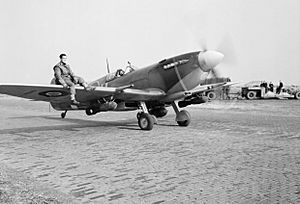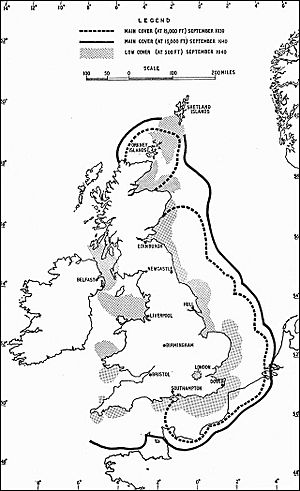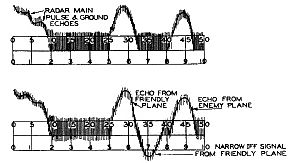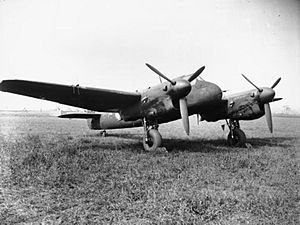IFF Mark III facts for kids

The IFF Mark III was a special radio system used during World War II by the Allied Forces. IFF stands for "Identification Friend or Foe." Its main job was to help pilots and ship crews tell if an aircraft or ship they saw on their radar screen was a friend or an enemy. This system was used from 1943 until after the war ended.
It was very important for planes, ships, and submarines. It also helped with things like search and rescue missions. Even the Soviet Union received 500 of these units during the war.
The Mark III replaced an older system called Mark II, which had been used since 1940. The Mark II worked by listening for signals from radar systems. When it heard a radar, it would send back a stronger signal. This made the "blip" (the dot) on the radar screen look bigger, showing it was a friendly aircraft.
However, as more and more radar systems were developed, they used many different radio frequencies. This meant that Mark II units often couldn't respond to all the radars. Pilots could never be sure their IFF system would work with the radars they flew near.
In 1940, a smart person named Freddie Williams suggested that IFF systems should use their own special frequency. This idea became very important when new microwave radars were invented. The old Mark II couldn't easily work with these new radars. So, in 1942, a new frequency band (between 157 and 187 MHz) was chosen just for IFF.
The Mark III started to replace the Mark II in 1942 and 1943. It was also used to create other systems, like "Walter" and Rebecca/Eureka. These systems helped planes find specific locations on the ground. They were used to drop paratroopers and supplies, and to find crashed planes. The Mark III was eventually replaced by the IFF Mark X starting in 1952.
Contents
How IFF Systems Developed
Early IFF: Mark I and Mark II
The very first IFF system, called Mark I, was tested in 1939. It was a simple system. It listened for signals from early British radars called Chain Home radars. When it heard a signal, it sent back a short pulse on the same frequency.
This made the aircraft's "blip" on the radar screen look bigger and stretched out. To make sure it wasn't just a group of planes flying together, the Mark I also had a switch that turned its signal on and off. This made the blip on the screen wiggle, showing it was a friendly plane. Only about 50 Mark I units were ever made.
The main problem with Mark I was that it only worked with the Chain Home radar's frequency. By 1939, other radars were being used, like the GL Mk. I radar and the Royal Navy's Type 79 radar, which used different frequencies.
To fix this, work on the IFF Mark II began in late 1939. The first Mark II units were ready in early 1940. This system was more complex. It had a mechanical system that could switch between several radio tuners. This allowed it to listen for radar signals from different systems. It would sweep through these frequencies every 10 seconds. The Mark II was the first IFF system widely used in operations by late 1940.
The Birth of IFF Mark III
Even as Mark II was being used, it was clear that it would soon have problems. More and more radars were being invented, and it was hard for one system to listen to all of them. Freddie Williams's idea from 1940, to have IFF systems use their own special frequency, started to look much better. This would also make the radio parts much simpler.
This idea became very important after 1941, when new cavity magnetron radars (which used very high frequencies) were introduced. The Mark II couldn't easily be changed to work with these. So, in 1941, the development of the Mark III began. Vivian Bowden was in charge.
The Mark III was simpler for aircraft. It removed all the old tuning equipment and replaced it with a single tuner set to a specific frequency band (157 to 187 MHz). This tuner would sweep through the band every two seconds.
However, things became more complex for the radar stations on the ground. Since the radar signal itself no longer triggered the IFF, a new transmitter had to be added at the radar station. This new transmitter was called an "interrogator." It sent out a special "interrogation pulse" at the same time as the main radar signal. The aircraft's IFF system would then receive this pulse and send back its own signal. This signal was picked up by a "respondor" at the radar station. This new setup led to the name "secondary radar," which is still used today.
This new design had two big advantages:
- Better Antennas: Old radar signals were usually horizontal, meaning aircraft antennas had to be horizontal too. This was often difficult to place on planes like the Supermarine Spitfire. With Mark III, the signal could be vertical. Mark III antennas were simple rods pointing down from the bottom of the aircraft. This gave them excellent all-around reception.
- Clearer Displays: With Mark II, IFF signals were shown on the same part of the radar screen as other aircraft. This could hide other planes. With Mark III, the IFF signal was received separately. It was often shown on a different part of the screen, or as a "negative blip" that stood out. This made IFF signals much easier to see and allowed them to be longer or even carry special codes to identify specific aircraft.
The Mark III also solved other problems. As more radars were used, aircraft IFF systems sometimes got too many signals and couldn't reply to all of them. The Mark III added a delay, so it only replied after receiving several pulses. It also lowered its output signal if it was being interrogated too much, which helped prevent distant aircraft signals from being hidden.
The new design also had a better power supply. This meant crews could adjust the signal strength on the ground, and no adjustments were needed during flight. This made the system much more reliable.
Mark III in Action
Soon after Bowden started working on Mark III, he met with Hugh Dowding, the head of Fighter Command. Dowding told him a sad story: "Last Saturday night, a Stirling bomber got lost coming back from a raid. It was thought to be an enemy. Two Beaufighters went to stop it. One shot it down, and then was shot down by the other Beaufighter. Two planes and a dozen lives lost! What are you going to do about it?"
This tragic event made the team work very hard to finish the Mark III quickly. It went into production at Ferranti in Manchester. A big test was done in Pembrokeshire with Mark III units in many different types of aircraft. This test was so successful that the US Army Air Force decided to use Mark III for their own planes, even though they had their own designs. This led to a huge production effort in the US.
One challenge with IFF systems is that switching from an old system to a new one is difficult. All planes in an area need to switch at the same time. This caused confusion during the war. For example, in September 1943, a ship called HMS Delhi reported seeing planes using Mark I, Mark II, and Mark III, and many friendly planes with no IFF at all! Still, the Mark III was considered a success.
One small change to the Mark III was the Mark IIIG. This version combined the normal Mark III with a second system tuned to the frequency of newer ground control radars. This created a special signal on the radar screen called the "crown of thorns," which helped identify friendly aircraft.
IFF for Special Missions
Beacon Systems
The Mark III's electronics were also used to create "beacons." These were special transmitters that responded to radar signals. For example, they were placed at naval bases and airfields. This allowed planes to use their anti-shipping radars as long-range navigation systems, helping them find their way home.
To use this system, a plane would fly in the general direction of the airfield. Its radar signals would hit the beacon, which would then send back a powerful signal. This signal could be received up to 100 miles away. The plane's radar operator could then tell the pilot which way to turn to fly directly towards the beacon.
In 1941, a battery-powered version of this equipment was tested. It was hidden within 15 miles of a headquarters. A British Bristol Blenheim plane easily found it. This showed how useful these beacons could be.
This idea led to the Rebecca/Eureka transponding radar system. Eureka beacons were dropped to resistance groups in occupied Europe. Planes equipped with Rebecca could then accurately guide supplies and agents to these hidden locations. The system was very secure because the beacons only broadcast signals when an aircraft turned on its radar, and only for a few minutes during the drop. This made it hard for German radio operators to find them.
Another similar system, called "Walter," was introduced in 1943. This was a small beacon carried on aircraft life rafts. If a plane crashed in the water, the Walter beacon would activate. This allowed search and rescue planes to find the downed aircraft from far away.
Around the same time, ground-based homing beacons were placed in Coastal Command aircraft in the Mediterranean area. These were called "Rooster." Planes on patrol would use their Rooster to mark enemy targets on other aircraft's radar displays. This allowed many planes to quickly gather and attack the target together.
Future IFF Systems
Mark IV and Mark V
Even though Mark III was very successful, it had some weaknesses. One problem was that it would respond to almost any signal around 180 MHz. An enemy who knew this could send out random signals and get information about friendly aircraft. Also, as electronics improved, it became possible to use even higher frequencies, which allowed for smaller antennas and less drag on the aircraft.
The US Naval Research Laboratory (NRL) had been working on their own IFF system, called Mark IV. This system used separate frequencies for the ground station (470 MHz) and the aircraft's reply (493.5 MHz). This made the systems more complex but meant that a response from one aircraft wouldn't accidentally trigger IFF units in nearby planes.
The Mark IV was kept as a backup in case the Mark III was discovered by the enemy. It was used a little in the Pacific Theatre in WWII but not in Europe.
Later, the NRL group started developing the Mark V, also known as the United Nations Beacon (UNB). This system used even higher frequencies (950 to 1150 MHz) and divided them into twelve different "channels." This allowed ground operators to tell aircraft to switch to a specific channel, making it harder for enemies to trick the system. It also had more ways to change the return signal, so ground operators could set a daily code and ignore signals that didn't match.
The US Navy made the development of UNB a top priority. A huge building was built for the development team, which was much larger than the Mark III team. The first systems were ready in August 1944, but the end of the war in 1945 slowed down the effort. Testing continued until 1948.
The Switch to Mark X
The IFF Mark III was finally replaced in the early 1950s by the IFF Mark X. This system used even higher frequencies: 1030 MHz for asking questions and 1090 MHz for replies. Using separate frequencies helped reduce interference. Later versions of Mark X included a "Selective Identification Feature" (SIF). This allowed the IFF to respond only to a specific pattern of pulses from the interrogator and reply with its own custom set of pulses. This made it very difficult for an enemy to trigger the IFF without knowing the correct code.
A serious concern for US Navy planners was that the Soviet Union had received 500 Mark III units during the war. They worried the Soviets might use these in the Korean War. This led to fears that an aircraft carrier might be attacked by planes that appeared friendly on radar. In May 1951, the US Far East Air Force ordered its units not to assume an aircraft displaying Mark III was friendly.
By this time, the US had started switching to Mark X, but this caused confusion, just like the switch to Mark III had. British and Commonwealth ships had not yet started this change. This led to a friendly fire incident on June 23, 1950, when HMS Hart fired on two P-51 Mustangs after bombs were dropped nearby. In July 1951, it was noted that "identification has been one of the more unsatisfactory features of this war." In August, the decision was made to treat all aircraft as friendly to avoid more friendly-fire incidents.
Images for kids






